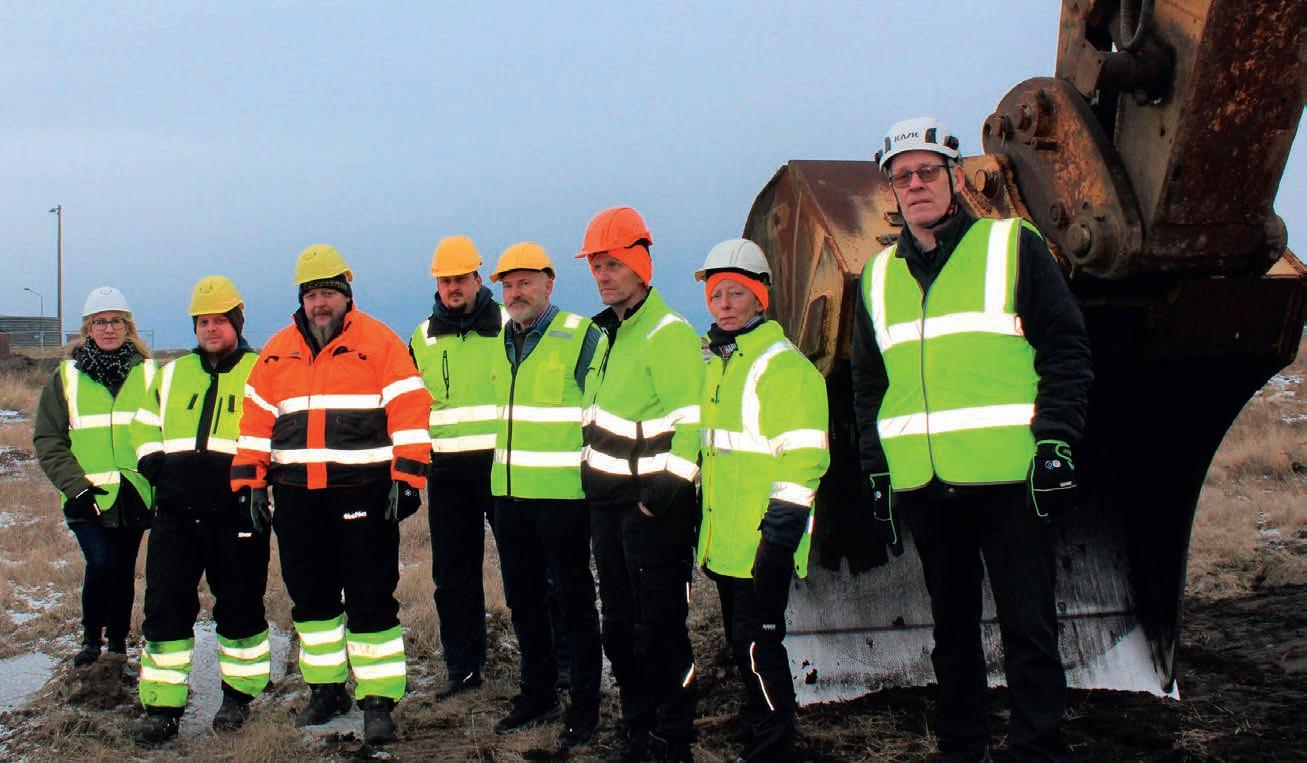
8 minute read
The latest innovations in aquaculture on land
Tackling RAS challenges
Investment in land-based farming systems must ensure a safe environment for the fish
Iceland’S largest fishing and seafood producer, Samherji, began construction work this month on a £9m expansion of its land-based Silfurstjörn fish farm.
Diggers moved in to begin preparing the site at Öxarfjörður in the north east of Iceland, which will boost output to around 3,000 tonnes.
Arnar Freyr Jónsson, operations manager at Fiskeldi Samherji in Öxarfjörður, said it was always a good feeling to get practical construction underway.
He added: “The preparation naturally takes time, such as working on planning issues, permit applications and more. This is probably the largest project in the field of employment in this area since Silfurstjörn was built in 1998.”
Samherji said five new pots would be built, which would be about half the size of the largest existing pots.
Samherji’s aquaculture division intends to bring its salmon production up to 40,000 tonnes over the next few years and the expansion of its Öxarfjörður farm was related to those plans, the company has said.
It is also being viewed as a precursor to a far larger project in Reykjanes, a few miles south of Reykjavik, where a £260m land farm powered by hot springs will be built.
This is just one of many land-based fish farm projects under way around the world. In December, for example, we reported that salmon farmer SalmoTerra had commissioned Graintech to build an 8,000-tonne recirculating aquaculture system (RAS) facility at Øygarden, near Bergen in Norway.
In the US, Aquaco has raised US$600,000 through crowdfunding to double the size of its RAS farm in Florida to a capacity of more than 85 tonnes. Aquaco farms pompano, otherwise known as sunfish.
Even Spain is getting in on the act, with plans to build the country’s first RAS site for Atlantic salmon. The farm, in Ramales de la Victoria, represents an investment of around €32m by Mexican-owned Norcantabric.
Investment in RAS farming is continuing at pace from Sweden to Singapore.
Land-based farming avoids many of the problems associated with marine fish farms, from sea lice to storms at sea, but it is not without its own
Above: The Samherji construction team Opposite from top: Monitoring Blue Unit data online; Fish welfare is a priority for producers

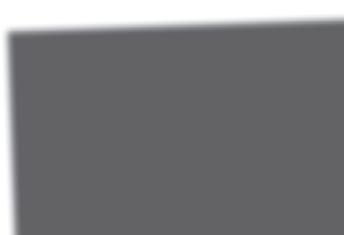
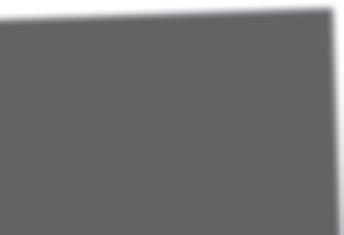

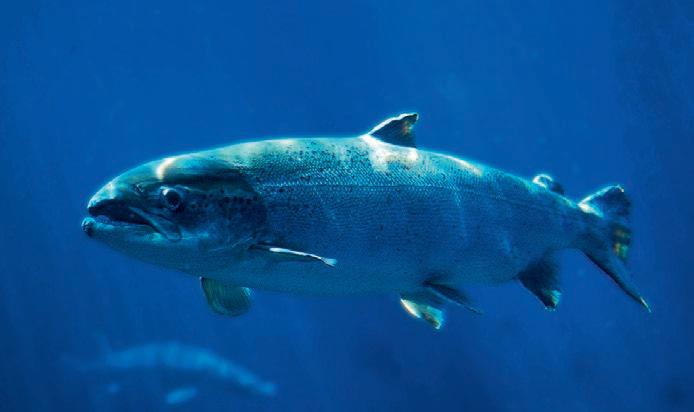
challenges. The fi sh are growing in an environment en� rely regulated by technology and it is crucial to be able to monitor that environment 24/7.
Danish company Blue Unit has been helping Mowi to do just that. Blue Unit produces data and visualisa� on technology to improve water quality control. Mowi’s land-based fi sh farm Steinsvik in Norway acted as a test loca� on for Blue Unit Solu� ons, a centralised monitoring system for RAS farms.
The specially designed sensors in the system collect 13 diff erent water quality parameters from up to 12 loca� ons in the facility in real � me. The sensors measure parameters including CO2levels, pH-value and hydrogen sulphide (H2S) contents.
All are relevant factors for Mowi, but levels of H2S, are a key metric. H2S can be dangerous because heightened concentra� ons of it can quickly lead to disease and fi sh mortality. A swi� reac� on is cri� cal when such concentra� ons occur.
Erik Salveson, COO of the Steinsvik farm, says: “The data we receive from Blue Unit is very instruc� ve to us. We have gained completely new knowledge on how things work, and it makes it possible for us to react and adjust so that we ensure op� mal condi� ons.
“What Blue Unit Solu� ons specifi cally can do for us is supply us with knowledge and data so we can proac� vely prevent disasters. By always following the data, we can jump to ac� on immediately in case of fl uctua� ons in, for example, H2S. By avoiding disasters, we can save a lot of money and prevent fi sh mortality.”
The system also registers all collected data in a registry that clients can access. They can then anonymously compare benchmark values with similar farms around the globe and become more knowledgeable on specifi c data.
Blue Unit uploads 2,700 datapoints daily to the cloud, which are accessible via external units. The system also incorporates an early-warning system and a built-in alarm system triggered at cri� cal levels.
It is also crucial to ensure that RAS facili� es are eff ec� vely and safely disinfected. Evoqua Water Technologies is a water purifi ca� on specialist

Above: Hilton Head Island, South Carolina
Technology takes centre stage
Owners and operators in the recircula� ng aquaculture systems sector will be gathering on Hilton Head Island, South Carolina, US, this March for RASTECH 2022. Taking place as an in-person event on 30–31 March, RASTECH includes speakers involved in current RAS projects such as Megan Sorby from the Kingfi sh Company, Erik Heim from Nordic Aquafarms and Jus� n Henry from West Coast Salmon. Delegates can learn about the latest RAS innova� ons from the Freshwater Ins� tute or drop into a technology session chaired by the President of the Aquaculture Engineering Society, Dr Maddi Badiola. For more informa� on on the conference, go online to: www.ras-tec.com
About Reed Mariculture
Reed Mariculture is a specialist supplier producing microalgae and zooplankton for healthy, high-quality and economical produc� on at fi sh, bivalve and shrimp hatcheries. As well as developing products specifi cally with RAS facili� es in mind, Reed has fi rst-hand knowledge of running RAS systems because it runs its own, producing live algae and zooplankton in a land-based facility.
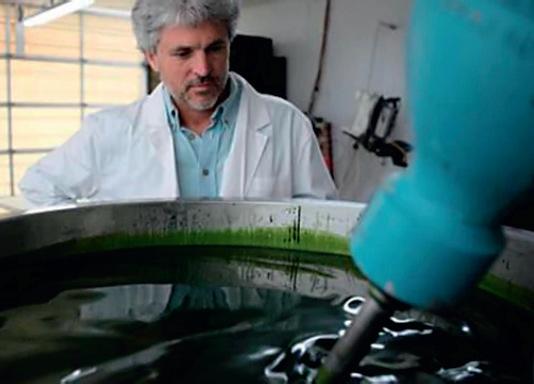


operating across a range of sectors from civic water supplies to high-purity water systems for pharmaceutical production or electronics manufacturing.
In aquaculture, Evoqua offers a range of solutions, but a key technique is to use ozone to remove impurities and kill bacteria without endangering the fish.
Ideal Fish, the only US-based producer of branzino (also known as European sea bass), required a solution to keep its RAS free from farm water pollution.
The team at Ideal Fish consulted the disinfection aquaculture experts at Evoqua to help find the most efficient and economical disinfection solution to help remove aquaculture pollution and create a better, more biologically efficient system for the fish to grow in.
Evoqua’s solution was based on the company’s MNG Series ozone generators delivering ozone production at an industrial scale.
The MNG Series ozone generators also feature Powertron technology, a novel power supply design that provides a new method of control power for precision O3 output, using less energy. The Powertron also operates quietly, which helps to create a better environment for the fish.
After some months, the team at Ideal Fish saw a definite increase in water clarity and fish performance, enabling them to further increase the growing and performance parameters with controlled and precise use of the ozone facility.
The application of ozone can be precisely targeted depending on need in different parts of the system.
Operations and alarm features are easy to operate and reliable, Evoqua says. As production grows and more ozone is needed, the smart module can adapt to the system’s needs at any time.
Additional reporting by Vince McDonagh.
FF

Above left: Norcantrabic’s site in northern Spain Left: Sea bass at Ideal Fish’s RAS site
Double protection

UV and Ozone present sustainable opportunities for protection against disease in land-based hatcheries
Aquaculture accounts for approximately half of the fi sh consumed worldwide, and increasing demand is driving the growth of land-based hatcheries. But, to stay competitive in an evolving market, land-based hatcheries need to make use of technology to improve production and prevent disease.
UV and ozone technology support land-based hatcheries by enhancing the water treatment process, for protection against disease and to help achieve greater yields.
UV light works by penetrating the cell wall of micro-organisms. Without the need for chemicals or residue in the water, the UV energy permanently alters the DNA structure of the micro-organism, which inactivates it and renders it unable to reproduce or infect.
For the prevention of disease, Evoqua Wafer™ UV systems comply with Norwegian Veterinary Institute (NVI) standards. Wafer UV models have been assessed for NVI validation using Aeromonas Salmonicida and Infectious Salmon Anaemia (ISA) organisms. When used in conjunction with Ozone treatment, this gives landbased hatcheries a double-barrier against disease. Ozone is one of the most powerful commercially available oxidising and disinfecting agents. Ozone gas quickly dissolves in water and then decomposes back to oxygen in solution, leaving effectively no residuals in the treatment stream. Rather than competing, UV and Ozone are complementary technologies. The combination of both UV and ozone technology can provide plants with a double-barrier approach for the prevention of disease and greater yields.
Learn more about Evoqua’s range of UV and ozone technologies for land-based hatcheries at
www.evoqua.com/en-gb

Performance limitations depend on feed conditions, overall installed system design, and operation and maintenance processes; please refer to Operations Manuals. For specifi c information on disinfection claims, please visit: https://www. evoqua.com/en-GB/articles/disinfection-performance-andvalidation/











